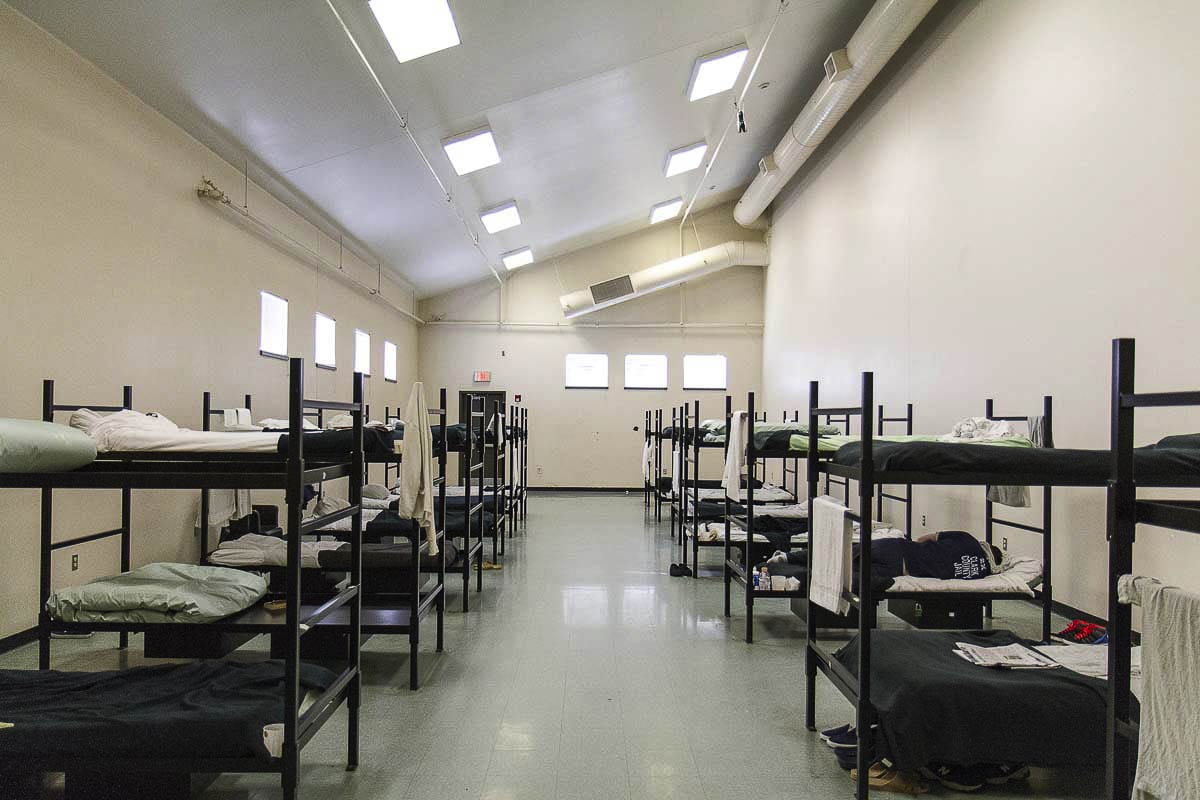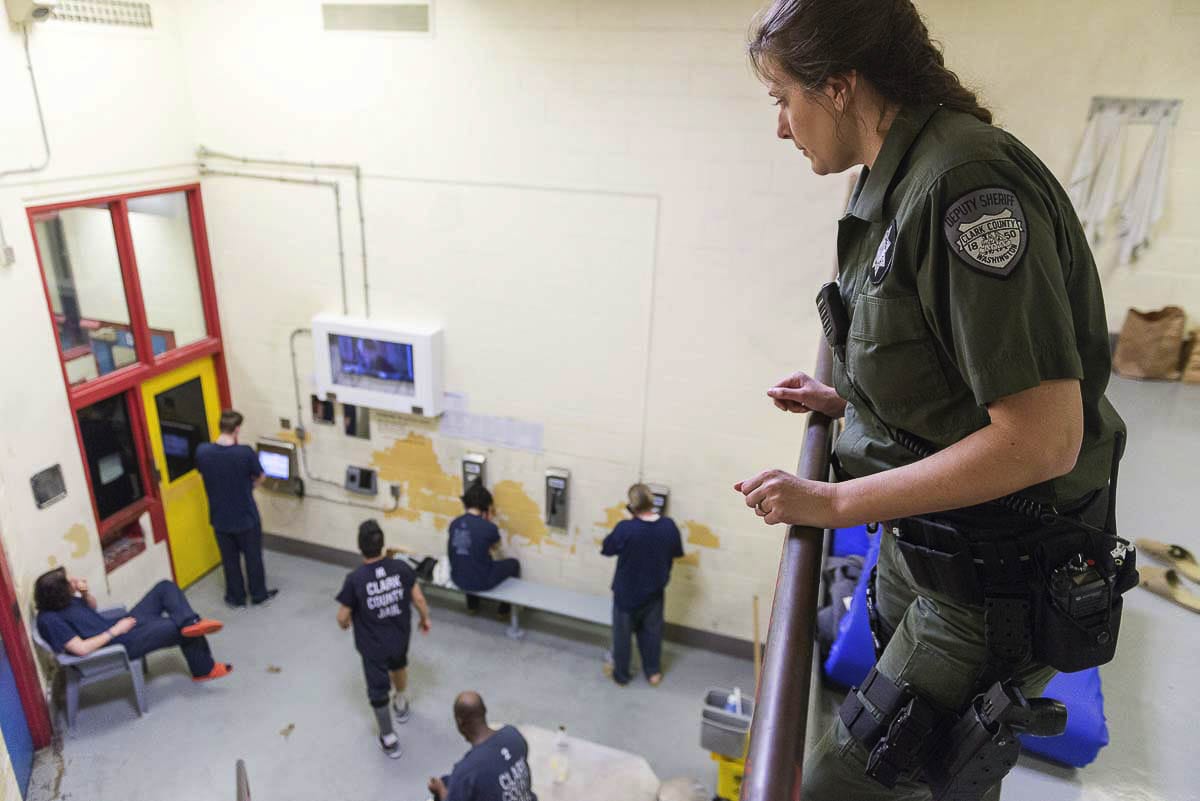Court delays and longer stays are putting the jail in a bind, with few options to address the issues
VANCOUVER — As the COVID-19 pandemic began to spread in earnest last Spring, the overcrowded Clark County Jail took steps to significantly reduce their inmate population.
Under the direction of Clark County Prosecutor Tony Golik, people facing charges on some drug and property crimes were released, with trial dates still pending.
That brought the jail’s population from nearly 700 in late February, to just 313 in March.
“I personally have not seen that since 1985,” said jail chief Ric Bishop during a work session earlier this week.

Despite those adjustments, the jail has still experienced a recent COVID-19 outbreak which, at last count, had spread to 44 inmates, creating the need for more space to quarantine people who are infected or exposed to a known case.
Bishop said the jail has 61 beds currently assigned to intake cohort housing, where inmates are held for 6-7 days until they’re medically cleared to join the general population.
While the jail has 516 total beds, Bishop said, their operational capacity is actually 430 due to the need to separate male and female inmates, as well as vulnerable or predatory individuals.
That was pushed to the limit when the inmate population climbed back to 433 at the end of October before dipping slightly in November.
“If this was a typical year, I would be able to tell you that we see the seasonally, where our population goes up in the fall, and then as we go into the holiday season it starts to drop,” Bishop said. “This is not a typical year, and I’m not comfortable saying what may or may not occur during the rest of the holidays.”
Driving the population growth has been a massive increase in the length of stay, Bishop said, which went from less than 20 days in January, to over 36 days on average now.
“As of today I have 54 people in the jail a year or longer waiting for trial,” said Bishop.
That is being driven by ongoing delays for jury trials, which were postponed for a while earlier in the year, and then canceled again as of late last month due to the increase in cases.
With the inmate population now over 90 percent felony-level suspects, and a lack of things to do, Bishop said, they’ve had to deal with an increasing number of violent incidents, and at least two attempts to breach exterior windows in order to exchange drugs or other contraband.
“We have increased the number of books, we’ve increased the number of games and are looking at other strategies to give folks things to do while they’re awaiting trial,” said Bishop. “But this is a serious issue.”

Other challenges include difficulties keeping up with laundry services, said Bishop, because those jobs are generally done by low-risk inmates, most of whom were released.
“Our medication-assisted treatment for opioid disorder has been going down to minimal services,” he added, “because we don’t conduct group meetings and we don’t conduct the counseling in groups because of COVID-19.”
Barring some solution to help reduce the population, or increase capacity in order to allow inmates to spread out, Bishop said the department is concerned there will likely be litigation brought against the county.
That could be expensive, but the potential solutions to the issue may be just as costly.
Bishop said his department contacted every other jail facility in the state to ask about the potential of renting beds. Only Snohomish and Skamania counties responded, for a total of 15 extra beds.
“If we were to rent 15 beds,” Bishop said, “the cost would be $37,000 a month, in a 31 day month.”
In addition, those jails would only take healthy, low-risk inmates, further limiting the number who could help with laundry services in Clark County. That might require hiring additional temporary workers at an estimated monthly cost of $52,000.
Other options could including implementing bail for non-violent class C or B felony offenders, expansion of electronic home confinement (which the county is already pursuing), and further deferring mandatory sentencing for misdemeanor crimes.
The county could also look to add capacity inside the Jail Work Center, though doing so could prove difficult.
“It would require a lot of work, even if we had the money and the staff ready to go to work immediately on it,” said Clark County Sheriff Chuck Atkins, “before you could make it feasible in terms of putting any felons down there whatsoever.”
Without money or time to retrofit the work center to accommodate potentially violent offenders, the jail would need to hire and train more staff, which would not only be costly, but take time.
Bishop said his department had sought to secure CARES Act dollars to address some of the issues, but ran out of time as other projects backed up during the pandemic.
The county is facing increasing pressure following a letter sent this week by the ACLU of Washington, Disability Rights Washington, Washington Defender Association, Columbia Legal Services and NAMI SW Washington, calling for the jail to cut its population.
“We think that — especially in the middle of a pandemic — it’s critical that Clark County do everything that it possibly can to reduce rather than increase its jail population,” Ethan Frenchman of Disability Rights Washington told Oregon Public Broadcasting.
County Council members at Wednesday’s work session urged the jail to remain in touch with the state’s General Services Administration about possible funding, and to get legislative lobbyists involved to push the state to act.
“A lot of this is driven by dictates coming down from the state in terms of what we can and can’t do in terms of trials,” said Councilor John Blom, who chaired the work session. “And so these are, and understandably so, these are costs that are being incurred because of their decisions.”




